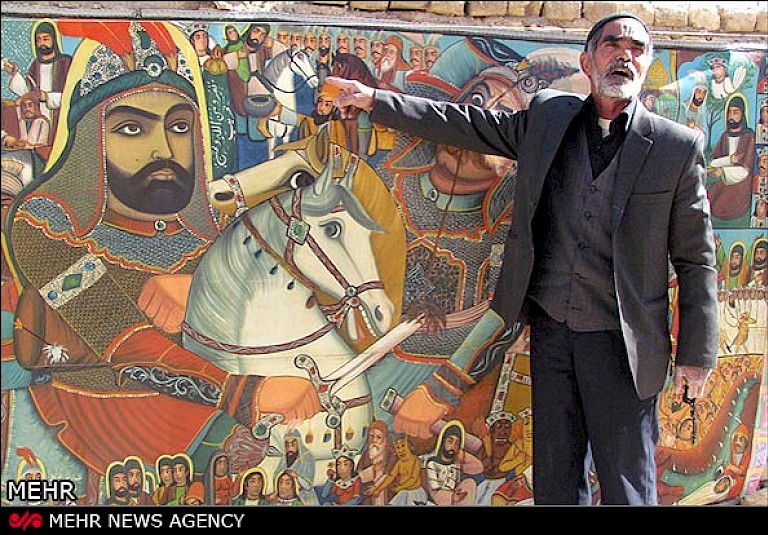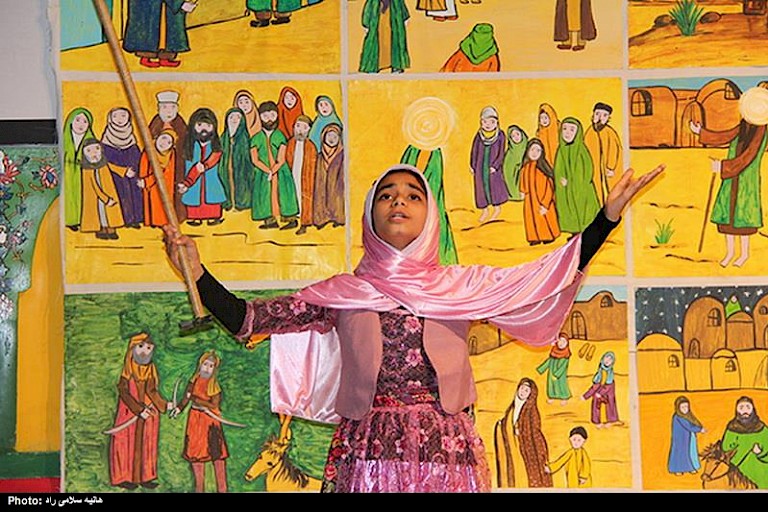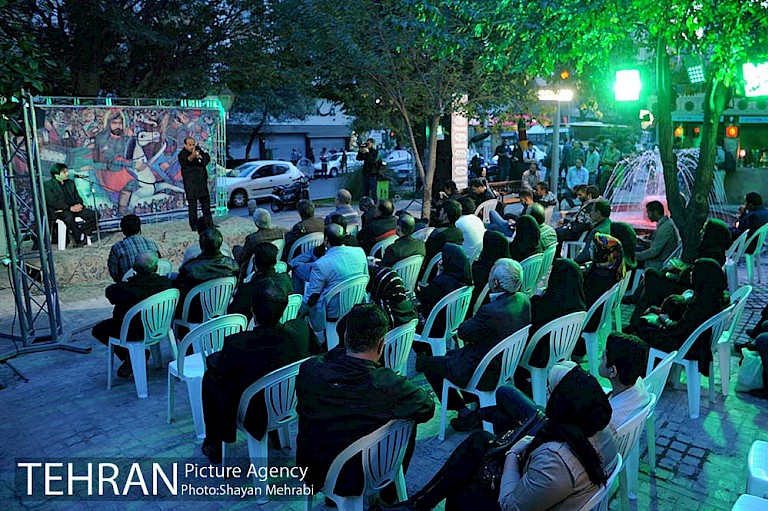



Ali Seidabadi, the editor of Tiny Owl’s Persian series says that when I was a child, a kind of art was popular in Iran, which I can describe as a sort of collective illustration reading. I have been captivated with this art for a while, thinking how greatly it resembles “reading” a picture book or an illustrated story, feeling amazed that nobody has yet mentioned this resemblance. This art-ritual is called parde-khani. There are illustrations on a large canvas named parde and a person called pardekhan stands before the crowd, points to an illustration with a stick, and narrates its story. This was a kind of street art and people, mostly children and teenagers, would gather in a square, where pardekhan would tell his stories. With a long wooden stick he would show the images and at the same time would tell the story of each majlis (act).
Each canvas comprised several parts called majlis, and each majlis had its own story, which was also part of the main story. Most narratives came from one of these two sources: the story of Imam Hossein, the third Imam of the Shiites, and Shahnameh by Ferdowsi, the great Persian poet who composed epic poetry. Pardeh-Khan had performed his work every evening in fields, teahouses, and crossroads and in general in the places in which people congregated and rest. All glitterati and common people respected him.
Since ancient times, Iranian’s culture was the source of thought and was considered as a tool for transferring affections and in general was the factor adapting human with his environment and other people. The Iranians employed different methods for transferring culture. Pardeh-Khani, which is full of cultural, religious, artistic and social aspects, is one of these ways. Pardeh-Khani is a kind of storytelling combined with eulogizing features, which is always accompanied with showing pictures.
However, the purpose of describing problems in this way was merely for fun and doing just a business? The answer is absolutely no. Instead, human tries to put into practice his goals and potential needs longing to turn them to feasible actions using his talking, behaviors, and figurative images. Pardeh (curtain), as an educational- entertainment media, created a kind of stream of consciousness in audiences via its story in story method and it was very attractive for audiences to virtually travel to different times and places.
The completion trend of Pardeh-Khani and Shabih-Khani as social, religious, divine and artistic approaches was started when the Shi’a religious became stronger in Qajar era. Pardeh-khan always emphasized on the educational and upbringing aspects of stories and he used to employ different techniques for obtaining this object. Of course in earlier times, religious stories were being narrated verbally but over time music and images were also employed for more impressiveness purposes.
The curtains were being painted by simple pictures, without any naturalism and shading techniques and traditional perspectives, which were being utilized in them with the aim of emphasizing the ideological and religious aspects in order to impress deeply the audiences. Breaking down the space, time and situations is one of the most important characteristics of the art of Parde-Khani resulting in a kind of suspension and postponement in story. Another characteristic of this art is the encounter of twofold forces clarifying the deep and complex concepts hidden in them. This duality and contrast gives the audiences the opportunity to analyze the messages of curtains and select their path. The existence of a kind of hidden agreement between the contrast subjects painted on curtains causes the audiences to understand relations between forces and promote their general awareness. This finally helps them select their way. Thus, we can argue that the existence of contrast forces both in story text and curtain’s pictures is an approach for audiences’ awareness and awakening purposes which makes them submit towards god’s will and leads them towards recognizing good forces and fighting with evil forces.
This great work of art which has a great integration with culture, tradition and religion of Iranian has been inherited generation by generation so far that we can see this art as a public art in streets of Iranian cities in special days and months such as Moharam (which is a Mourning month) for Muslims all around the world as well as traditional Iranian festivals.
The main purpose behind this work is to familiarize the younger generation with Mythologic characters of ancient Iran such as Rostam and Sohrab.
All copyright belongs to Shanghai Academy of Fine Arts, Shanghai University.



